On the NonCorporate blog, we’ll be interviewing people who are out there building a non-corporate economy on the ground right now. We’ll be finding out exactly what they’re doing, what they’ve achieved, what problems they face and what they’d like to see change – and we’ll be asking them how we might co-ordinate the non-corporate sector to punch above our weight.
First in line is Jon Halle of Sharenergy, a co-operative helping set up community energy schemes around the country.
NonCorporate: what do you do?
Jon: We’re helping people to set up, own and run their own community-owned energy societies. That’s generally a group of people, perhaps in a small town, who would like to own and run some wind turbines nearby, or a hydro-power plant nearby, or some solar panels in a field or on roofs, or some sort of low-carbon heating system for their village or town.
That’s usually how it starts. Then typically they bring in a wider group of people, sometimes all locals, and sometimes people from across the UK, who like the sound of the project, and want to put in some money or other forms of support. So a co-operative energy society is organised, under the banner of what’s come to be known as community energy.
There are community energy societies all over the UK – from Cornwall to the Shetlands, via Wales and lots of communities across England. é
The first generation of these projects were large wind turbines, and then there was a second phase, with the introduction of the ‘feed-in tariff’ – a government support scheme providing money that made the scheme work for solar, medium-scale wind and hyrdo projects too. That provided a real boost, and lots of local projects were developed. Now we’re involved with searching for the next phase – community energy 3.0 if you like, as government support is being withdrawn (see below).
NC: why do you do it?
The main reason is that it puts energy into the hands of normal people. Plus, like any community project, it tends to bring people together – and often people who might not already know each other, and who will be coming to the project for very different reasons. Some might be attracted to the community aspects, others to the engineering challenge, others for non-corporate reasons, or because they like co-ops, for energy security, for environmental reasons, or just for the investment opportunity. They can bring together Tory MPs, retired engineers and environmental activists in ways that not many projects can.
It also provides ordinary people with ownership of energy infrastructure. This isn’t even happening via the state now, and it’s down to the enormous scales involved. There’s very little in terms of energy infrastructure that we can put our hands on and say that it belongs to us. It’s happening, slowly, and people really want it – they want to be able to have some control over the core services that they depend on in their locality.
Then there are the investment opportunities. If energy companies are unpopular, then banks are even more unpopular, and so when people realise that they can get a better return from investing in a community energy scheme than putting their money in a bank, they’re very happy to do it.
And finally, of course, there’s carbon. I think that a lot of people, quite rightly, feel that not enough is being done to reduce carbon emissions, and so they want be part of something that’s happening, even if it’s relatively small.

Some projects that Sharenergy have been involved with – 1. the Small Wind Co-op.
NC: what successes have you had?
There have been a lot of successes – some of them quite surprising. Some projects have failed, but the majority of projects that have been started by communities have actually come to fruition, and so there are wind turbines – mostly in Scotland and Wales, but some in England too – that are owned by co-operatives. Some have been running for a long time – some to the point that they have come to the end of their life and have been replaced.
There’s a huge range of community buildings (and also non-community buildings) that are now covered in solar panels that are owned by members of the local community. Brighton solar, for example (not one of our projects, but I’m talking about the whole movement now), are very interesting because they own solar panels that are on community buildings and some that are on commercial warehouses as well. They may well be the biggest owner of solar power in Brighton.
There are lots of innovative projects too – like community heat projects, or the Energy Local projects in Wales, where people can effectively buy electricity directly from their local hydro scheme (more below).
Talking about renewables generally, I always tell people that there’s a nearby country that produces over half of its electricity from renewables. People think I’m talking about Denmark, but I’m not – I’m talking about Scotland. But we’re still scratching the surface. There’s enough of a renewable resource out there to run the whole of Scotland, and ultimately, everywhere, on renewables, I’m sure. We just need to get out there and do it. There’s more of a challenge coming as vehicles switch to electric, but it still has to be done.
NC: what problems do you face?
Government support has now effectively (and literally) been withdrawn. The feed-in tariff is ending in March next year, and there’s no hint of a replacement – and we don’t think there will be one. So there will almost definitely be no form of subsidy for renewable energy at all, whether owned by a community energy group, a corporation or a household.
It’s going to be difficult for schemes using the current model to be financially viable. Hydro-power schemes will be the first casualty, in that hydro projects require quite a lot of subsidy in most locations in order to add up. They’re quite expensive, apart from the usual compliance with regulations – for example, if the National Grid needs an upgrade in a remote location to cope with the input from a new energy project, then the project will have to pay for that upgrade. This can often be a major part of the cost.
Then for hydro, there may be other costs. The Environment Agency might approve a hydro project, but require that a fish pass be built – a structure that lets fish swim up a weir. In some cases this might double the cost of the project.
Another major problem is that it’s difficult for local groups to provide energy directly to their members. Groups have to sell the electricity they generate to the energy companies via the National Grid (for around 5p per unit), and their members have to buy it back via the National Grid (for over 15p per unit).
NC: how do we overcome those problems?
It’s important to understand that ultimately, it’s down to us. We can’t rely on government subsidies, or even regulation. We – as in everybody who’s interested – have to do it ourselves. That’s what NonCorporate is all about, isn’t it? And community energy groups have managed to do it too – albeit on a small scale, and very localised. But nevertheless, we’ve had people investing significant sums of money, because they believe in this, and it works. It would be nice if we had government support, but we can’t let it stop us if we don’t get it.
In terms of financial viability, we might have to start thinking a bit bigger. Instead of community energy co-ops covering a village, maybe we should be thinking in terms of community energy covering counties or regions, to compete with the big energy companies and get really good prices, to attract a bigger customer base, and to mobilise an army of volunteers to help get solar panels on as many roofs as possible. Volunteers could find the roofs locally, and convince their owners to get panels on them. We have to be careful not to take away the local responsibility and the pleasure of doing something in the community, so the key thing is to try to find the balance between the scale we need, and the local involvement. That’s what we’re trying to do at Sharenergy.
Hydro is problematic for the near future, as mentioned above (althought there may be exceptions in the Scottish Highlands or parts of Wales, but I don’t see new lowland schemes happening soon); and planning permission for large wind turbines seems only feasible in Scotland or Wales at the moment. There’s effectively a planning moratorium on wind across the whole of England. 10:10 are running a campaign on this – because most people don’t know about it, and wouldn’t agree with it.
The Energy Local model in North Wales is being used to solve the problem of not being able to provide electricity to members locally. In Bethesda, locals are using this model to obtain electricity directly from their local co-operatively-owned hydro scheme. This model is genuinely innovative – they’ve managed to persuade the electricity distribution authorities to allow them to tap into the network on the basis that they can reduce overall demand and provide energy security locally. They don’t have a mini-grid – they’re using the existing National Grid to do this. Now the National Grid is heavily, and understandably hedged around with regulation, but they’re managing to get in there and negotiate the delivery of the electricity that they generate to local homes.
But this problem is being overcome slowly I think, as new solutions come online. We’re moving very slowly to a system where, instead of having centralised power stations with electricity radiating from them, we’re building a system where electricity generation might happen at different points on the network – moving to more of a web structure rather than spokes coming out from a central point. Community energy schemes are very influential in this movement.

3. Wedmore Solar.
NC: overall, are you optimistic about community energy?
Yes. OK, progress is slow and difficult, but often, things that happen quickly then disappear quickly too. We don’t want to be a fad – we want solid, sustainable foundations.
But we know now that it works. It’s not a juggernaut that’s taking over the energy sector (yet), but lots of communities all over the country have now set up their own energy schemes, people have invested in it, and are getting healthy returns, and people have been involved with their time and their hearts. It works, which is very encouraging. The trick now is to scale it up.
Also, no-one is actually against community energy – no-one is saying that it’s a bad idea. You might even have people who work in the corporate energy sector, who also have shares in a community energy scheme, or are involved in setting one up. No-one is actually opposing us.
At the moment, the delivery of energy is dominated by thinking about power stations that are on all the time, but that’s not how renewables work, and it’s not how demand works. I think future energy delivery will be much more flexible and versatile, in ways that suit renewables and community energy.
We have Economy 7 at the moment for example, heating up storage heaters at night, cheaply – because of nuclear power stations, that are on all the time, including at night, when demand is low. So Economy 7 is a very simple idea for matching electricity demand and supply. But what I foresee is a grid over the next 30-50 years where those sorts of arrangements become much more subtle and much more responsive. The general term is the ‘smart grid’, where, instead of pumping loads of electricity in willy-nilly, when you can do it, and using electricity when you want it, we start to question whether we need to use the electricity right now, or could we switch this big appliance on when it’s windy, or sunny, rather than just when we feel like it. If the price is much lower, then this is a good incentive to change habits.
Small, local grids could be part of this, especially in more remote locations. But I think that a lot of people come from a ‘Small is Beautiful’ angle, and consider the National Grid to be a big, lumbering thing, and that we should federate into small networks. I’m not sure this is true. A big misconception about the National Grid is that there are huge losses in transmission. For example, people might say that the Grid is only 30% efficient, and this is true if you take the whole, end-to-end efficiency from a coal-fired power station – i.e. you put in 100 units of energy in coal, and by the time it comes out of your plug socket, there’s only 35% of it available.
But almost all of those losses happen in the coal-fired power station. The main transmission system – the pylons that run up and down the country – loses about 3%. It’s quite efficient. It’s in fossil fuel generation that the real problems arise. So I think that the way forward is for community energy schemes to generate energy, but distribute it via the National Grid, rather than focusing on building local distribution networks. It also allows renewable energy to be delivered from where it’s generated to where people are. So, for example, people in London who buy renewable energy from Co-op Energy, their nearest large sources of renewable energy are offshore off the Kent coast (the London Array), or on land – Westmill, near Swindon. The good places for wind and hydro are often a long way from cities.
NC: where can the public get non-corporate energy
Co-op Energy has an agreement with Bethesda community energy group (mentioned above), to buy the electricity produced locally, and sell it to members of the group. So local customers can sign up to a special tariff with Co-op Energy to get much cheaper electricity at the times that their hydro scheme is running. This is a pilot project, and Co-op Energy are doing a lot of work to enable this to happen, and Energy Local are doing more trials.
Co-op Energy also allows anyone to purchase electricity generated by community energy schemes, although you won’t get the discounts that local members of the schemes do. Co-op Energy is the place to go first, really, if you want non-corporate energy.
There’s also a new crop of local-authority-sponsored energy suppliers, like Bristol Energy, who are connected to existing community energy groups. Robin Hood Energy in Notts is another one, as is Our Power in Scotland.
Plus of course you can also think about installing solar yourself or setting up a new energy co-operative.
NC: can we co-ordinate the non-corporate sector to punch above our weight?
I think co-ordination is important. We mustn’t rely too much on governments to do the right thing. If they want to help, great, but we mustn’t expect it. I wrote articles recently for Stir magazine, and found myself constantly fighting the urge just to sound off about the government’s terrible renewables policy, which of course means the government is still setting the agenda – and we have to move beyond that as well. It’s fine to say that we have to do things, but now it’s time to up the speed a bit. It’s all going too slowly. Any initiative that helps to bring more people in has to be a good idea.
One way that the non-corporate sector might be co-ordinated is through volunteering. We already have this for organic farming, with the WWOOF organisation. It’s almost part of the business plan of every organic smallholding to host WWOOF volunteers now. Maybe this could be the case for the non-corporate sector. For example, I’d like to get ten local people together in a town, who are interested in spreading renewables, and ask them to go to all the buildings in town with a big roof, to ask if they will host community energy solar panels. I’d like to train them up so that they can talk knowledgeably. People who know their local area would be by far the best people for this role.
I also think that we need to rebuild some sense of a movement. When I first got involved in the Green movement in the UK, there were really exciting initiatives like Reclaim the Streets, road protests etc. – quite rowdy and good fun for a young person. But there were older people involved too, coming from the peace movement, or just through personal interest. It felt like a continuum, but with a new edge. I don’t think we have this feeling in Britain today, because we haven’t found a way to knit things together for mass participation, and involving lots of different kinds of people – because climate change is going to affect everybody.
NC: what can people do to help, as individuals?
Switch to a non-corporate energy supplier.
Invest in community energy (here are live share offers from Sharenergy).
Spread the word – get friends and family doing these things too.
Help start a community energy scheme. There are so many aspects to attract lots of different kinds of people to this. There’s the engineering side, there’s the community side, there’s the finance side, there’s the sustainability aspect, the promotional aspect or the co-operative aspect. If you think you’d like to set up a local community energy scheme, get a group of local people together and let’s talk.

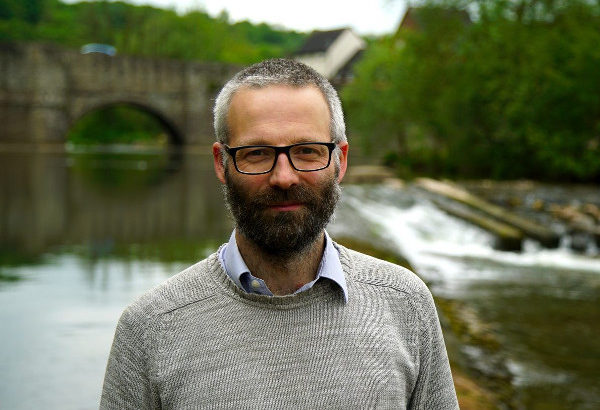


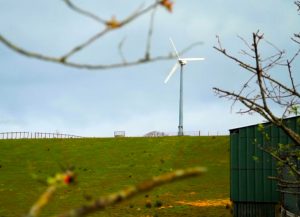
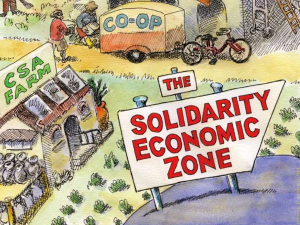
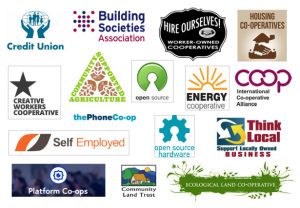

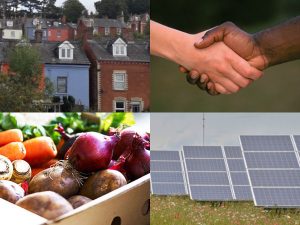
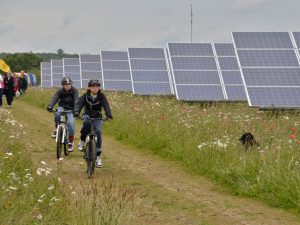

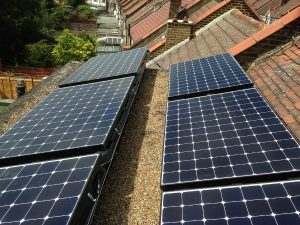
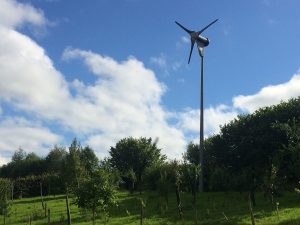
5 Comments
SO … I just checked out Our Power, and was horrified to read that they are committed to the dreaded smart meters, with all the usual corporate fluff about how wonderful they are. But … are they wonderful? Are they really? I personally am committed to resisting them, until the day the control system makes them absolutely mandatory – on that day … well … I just don’t know what I will do. Maybe it’s my suspicious mind, but I started thinking, is this just a way for the powers that be to coerce folks into accepting them. Are they dangling a carrot, by offering us community energy? The real agenda being smart meters.
I think I’d like to know more about “free energy” If I was going to invest, that’s probably the route I’d prefer to take – work on helping in the development of, for example, the QEG rather than solar or wind. Much as I love the idea of community anything, in this case I’d rather see free energy being what takes over from corporate energy – dirty electricity in every sense of the word.
Dave, I object to Akismet collecting my personal data. I strongly object. I think I am going to have to unsubscribe because of it.
Chrissie – I’ll try to get Jon to respond about smart meters, but don’t bother looking into free energy devices until the inventor of one gets a Nobel prize – because if one ever works, that will definitely happen, as they break the laws of physics. They’re scams. https://www.metabunk.org/debunked-quantum-energy-generator-qeg-10kw-out-for-1kw-in.t3572/. They provide free information to build one, then charge you consultancy fees to put it right when it (obviously) doesn’t work.
Smart meters are not anything particularly alarming from my point of view. Current meters just record all usage irrespective of when the power is used. Smart meters record usage against time. Unless your electricity usage patterns express something deeply private there’s no particular reason to object to these data being collected and kept. Knowing when people use electricity can be an important part of a future, flexible electricity system, which is pretty much essential if we are to move away from fossil fuels. So from a climate care point of view smart meters are a step in the right direction. It’s not really corporates who are pushing them, they’ve been slack in implementing them. And Ourpower are not a corporate setup – owned by housing associations, members of the public etc.
CC – I’ve just started working with LowImpact doing website stuff – so I’m not fully up-to-speed. I am very keen on data privacy, too, so thank you for bringing this up!. I’ve just had a look at Akismet, and have the following comments:
1/ Akismet is well-intentioned – it’s a filtering service to reduce spam in comments – to increase the usability and quality of the site.
2/ Akismet is produced by Automattic – the organisation behind WordPress. They have a decent reputation as regards privacy etc. Which is not to say that i can prove to you that they aren’t doing dodgy things with user data.
3/ In order to filter comments, they do indeed look at all comments, and potentially process them outside the EU – and in order to build their filters, they will have to retain some data in some form (however anonymised). So you have a point about data collection – although I’m unclear on exactly what data, and exactly how it is held. This is what they say:
> “The only information sent to Akismet when a comment is tested for spam is information that the commenter provided: their name, email address, site URL, and comment (plus other non-personal information like the current time, etc.). This information is not transferred to any non-Akismet servers, but we cannot guarantee in which country it will be processed. To that end, we have signed model contract clauses with our Irish subsidiary that cover the transfer of data in and out of the EU for processing”
4/ You can read Automattic’s Privacy statement here: https://automattic.com/privacy-notice/. The most worrying clause imho is this one:
> “Third Party Vendors: We may share Site visitor information with third party vendors who need to know this information in order to provide their services to us. This group includes vendors that help us provide our services to our Users and their Sites. We require vendors to agree to privacy commitments in order to share information with them.”
– to my mind this is very vague as to who data is shared with, and for what.
5/ LowImpact does not use WordPress/Automattic or any other services to include advertising on the site. All banners etc are added manually. Thus there is no strong reason for shared user data to be sent to third parties for ‘provision of services to us’ in targeting of adverts or similar.
6/ Here is the email for contacting Akismet directly should you wish to exercise your data rights under GDPR:
For Akismet Accounts: https://akismet.com/contact/.
We will be discussing the site’s use of Akismet soon, with removal of the service definitely on the table. We will communicate our decision asap.
I hope that this is helpful, and that, in the meantime, you will stay a user of the site.